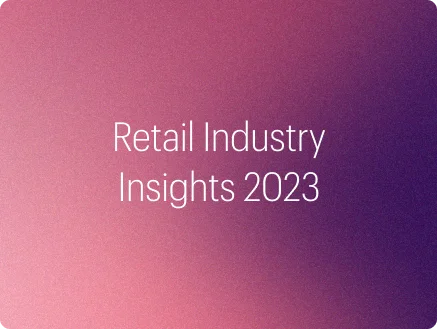A data science professional with over three years of experience in working with Fortune 500 organizations across industries, what Ashish Sharma looks forward to the most is playing a key role in the technological transformations re-shaping the global analytics and consulting space. With expertise in both building cutting-edge solutions and leading engagements with clients, he keeps a keen eye on the latest trends and revolutions in the market. In this Q&A, Ashish weighs in on the retail experience of the future and the tech-driven innovations to watch out for.
Q: What advantages do brick-and-mortar stores offer that other sales channels cannot replicate?
Ashish:There are two major advantages when it comes to brick-and-mortar stores: the first is customers’ ability to try out products before they purchase them. It makes a significant difference when you can gauge products’ tangible parameters, from color and texture to taste and smell. The concept of “try before you buy” is essential to retail, and this is an experience best offered in brick-and-mortar stores.
With physical stores, there is a greater scope for improved customer experience, with store associates offering help with a range of needs. Brick-and-mortar stores also provide a greater ease of use and navigation, which e-commerce websites cannot fully replicate.
The second aspect in which brick-and-mortar stores excel—and this is where they make up for the pitfalls of e-commerce—is in keeping the number of returns to a minimum. With the proliferation of e-commerce, several retailers have weighed the cost of losing customers against the cost of returns to choose the latter, although returns create a significant resource and finance drain for organizations. With brick-and-mortar stores, it becomes much easier to monitor returns, check product quality, and take action in case of misuse/damage.
Q: What are the key areas in which analytics can be used to help optimize in-store operations? Could you give us a real-world example?
Ashish: Demand forecasting is a classic problem—and solution—that a lot of retailers have looked to in order to estimate demand, maintain adequate safety stock, and reduce lead times. These are crucial to achieving the end goal of customer retention, because at the end of the day, all it takes is an out-of-stock product for customers to turn to other retailers in the market.
An application we developed for a fashion retailer looked at an interesting angle to this problem: How do we forecast demand for limited edition products with no prior history of sales in the market? In the absence of historical data, this made for a fascinating challenge, and we were able to draw on new sources of data to estimate units required and safety stock for a limited-edition series.
The solution that we created for the fashion retailer saw great success – their demand planning became much more efficient, which enabled them to stock the right products in their stores at the right time, and the accuracy of the solution, despite the unique nature of limited-edition product demand forecasting, stood at an excellent 90%.
Q: How can AI enable seamless store design?
Ashish: A key area in which AI is bolstering the in-store experience is through assortment and the prioritizing of product placement. Everything in a store, right down to aisle layout, product display, and assortments on shelves, can be designed and optimized using AI to achieve the best results. For instance, the choice of placing refrigerated products near the checkout counters, or even placing one set of grocery items next to another, can be made by tapping into data derived from customer basket analysis, transaction histories, and so on. By keeping an eye on the product combinations and sequences that customers are likely to purchase, store design can be updated periodically to enable seamless navigation and shopping.
An engagement we worked on where we were able to implement this kind of technology was with a leading apparel retailer: we helped them prioritize clothes for mannequins based on bestsellers, visual appeal, and a range of other metrics. Data-driven insights can help retailers achieve greater flexibility and efficacy when it comes to displays in stores.
Q: What are the new, emerging technologies that can give customers an excellent store experience?
Ashish:Virtual reality (VR) tools are certainly on the rise in terms of optimizing the store experience. For instance, our in-house team created virtual reality shelves where people could check out products. This exercise provided rich data on the kind of shelf assortments that do well, the displays that customers prefer, how customers interact with products, and how shelves can be optimized further using data.
The concept of “try before you buy” is thus extending to the virtual space with virtual shelves and fitting rooms. Businesses are using a combination of VR and Augmented Reality (AR) to drive customer engagement and sales across a range of product types, including clothes, shoes, makeup, and eyewear. This has really helped bring the traditional in-store experience to customers, with an innovative twist.
In addition to these, staff-free and cashier-less stores, which have emerged most prominently in response to social distancing needs, are also blurring the boundaries of the digital and physical; with a range of connectivity technologies enabling a smooth shopping experience. There is a lot of exciting tech to look out for on this front, such as chatbots and personal assistant tools, for instance. Apart from enabling a contactless experience, these technologies can be deployed to provide customers up-to-date and personalized information. Virtual floormaps can also be of great use here in helping customers navigate to the right sections of stores.
Q: What is the extent to which you think robots can play a role in brick-and-mortar stores?
Ashish: I believe this technology is quite far from reality right now, with isolated instances of adoption in retail. Moreover, the major aspect of the in-store experience is human interaction, with robots might not be able to effectively replace.
However, a major area in which retailers can look to robot adoption is for warehouses: for heavy, labor-intensive tasks including transportation and loading. Robots can serve as an effective means of complementing humans and enabling greater efficiency. As humans can be prone to tiredness or error, deploying robots at the warehouse front would enable greater speed in operations.
The benefits offered by robots would be two-fold here: taking on challenging physical activities, such pallet loading, picking, large object installations, and the transportation of heavy loads. In addition, they would also be able to take on potentially hazardous tasks, including precision welding and working with electrical appliances.
The second benefit would be replicating human activities that are both time-consuming and tedious, including handling packaged products, placing labels, defect checking, and so on, which would free up human capital to focus on higher-order tasks.
Q: What advice do you have to retail businesses looking to augment products through AR/VR?
Ashish: Considering the pandemic as a scenario that is likely to persist in the near future, AR/VR technologies can play a major role in bolstering the retail experience. As in-store experiences continue to be greatly valued by customers, the time is ripe for businesses to capitalize on customers’ emotions and perceptions.
Using VR tours and virtual fitting rooms will help really connect with people’s emotions and give them the store experience they have missed out on for the last couple of years. While the actual in-store experience remains irreplaceable, there is great scope to experiment with new technologies: for instance, creating a detailed floorplan using 3D, AR, and VR technologies to offer a truly immersive experience.
Further, while these technologies will be useful in the short term, long-term investments will also benefit retailers, helping them reach a wider customer base through e-commerce adoption. In the event that the novelty of the brick-and-mortar experience wears off, such tech will also be useful in creating next-gen retail experiences in the future.
Q: We’ve heard of drones for last-mile delivery. What sort of role do you expect drones to play in retail in the near future?
Ashish: Drones have a great deal of utility to offer in the current era of flexible, efficient, and rapid deliveries. I see this technology playing a major role in making cost-effective batch order deliveries a reality, and this will save the time involved in consolidating orders, deploying delivery personnel, having orders picked up from stores, making returns, and so on. A lot of interesting analytics, in terms of analyzing customer requirements, optimizing delivery routes, and keeping customers updated on delivery statuses, can be deployed here, and the result will be improved last-mile delivery, with drones becoming highly cost-effective and flexible tech in the long run.
Bonus Q: What in-store tech revolution are you most looking forward to in the near future?
Ashish: I’m looking forward to seeing a more pervasive use of Virtual Reality in stores – the innovations offered by VR tools and trial rooms would make the in-store experience much more immersive, interactive, and enjoyable. Also, I’ve always wanted to see robots in stores – interacting with them would make any retail experience truly memorable!


